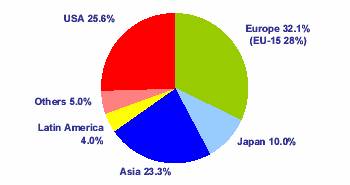
CHEMICAL
INDUSTRY
WORLD
At the end of 2002 Europe held a 32% market share of world chemicals production.

However this share will continue to erode and the highest grow market
will be the Far East.

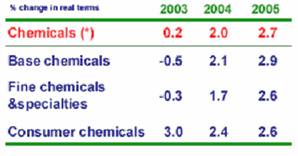
Chemical
production in the emerging countries will grow much faster than in advanced
economies

Whereas anemic growth rates will be experienced in other sectors, Asia
will enjoy 7% growth rates this year and next.
Chemical
Production Forecast
Real
changes from previous year (%)
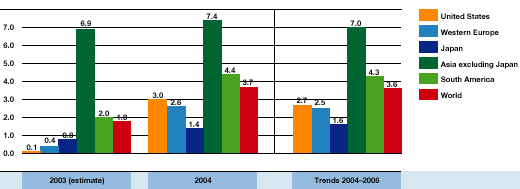
EUROPE
The chemical industry is an
important sector for the European Industry:
Early
indications are that output in the European chemical industry in 2003 showed a
slight decline of 0.5%. That was in sharp contrast to the bullish outlook
presented by the European Chemical Industry Council (CEFIC) late in 2002, when
economists predicted growth in chemical production of 2.4%. Problems with the
economy had already become apparent by mid-2003, however, when projections were
slashed to 0.7% growth for the full year.
European production is
likely to fall to 16-23% of the world total by 2015.
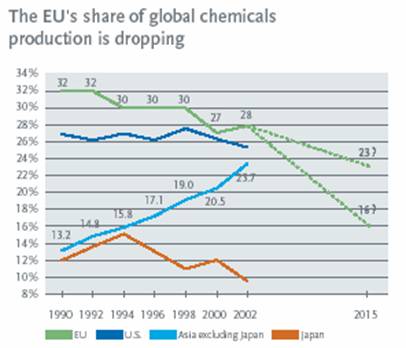
World Chemical Outlook - Europe
ONE
OF THE FEW countries to show strong growth in production in 2003 was the Netherlands.
That growth, however, said C. A. Linse, chairman of the Association of the Dutch
Chemical Industry, was due in part to the commissioning of a number of new
installations throughout the year, as well as the optimization of the production
capacity and efficiency of a number of existing installations.
The
chemical industry in the Netherlands had an
annual revenue of $35 billion in 2002 and employed around 75,000. This
represents 15 percent of the industrial output of the country and 10 percent of
industrial employment. Basic chemicals account for about 60 percent of this
revenue and specialty chemicals for 40 percent. Basic chemicals, which provide
the shoulders for the specialty chemicals industry to stand on, are produced in
several clusters located in Delfzijl, Heerlen/Geleen, Rotterdam, and Terneuzen.
Specialty chemical producers are located throughout the country. The European
Union is the home market for the Dutch chemical industry. It exports about 70
percent of its products. The Dutch chemical industry accounts for over 6 percent
of the chemical production in the European Union.
In France, production of detergents and
personal care products showed similar growth, at 6.3%. Commodity organics were
up 0.6%, whereas commodity inorganics production fell by 0.8%; production of
specialty chemicals managed 0.4% growth.
Production
of chemicals in Germany, the largest economy
within Europe, was up a meager 0.5% in 2003 over 2002. And for 2004, it is
projected to show only a modest growth of 1.5%.
Russian
investments
in the chemical and petrochemical industry reached $312 million in the first
half of this year.
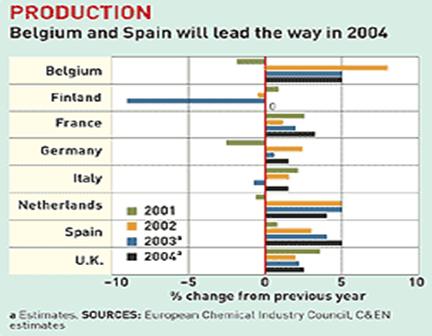
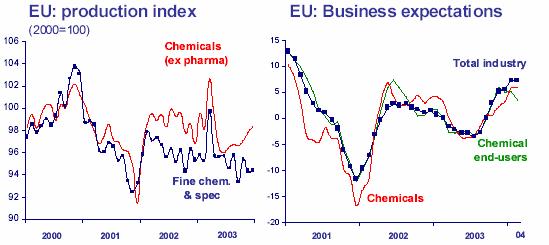
According to Cefic, the
European Chemical Industry Council, In 2005, the overall output in the EU
chemical industry (excluding pharmaceuticals) is forecast to grow by 2.7%,
attaining 3.1% if pharmaceuticals are included (Chart1). Most EU chemicals
sectors will see better growth than in 2004, especially polymers and specialty
and fine chemicals (Chart2
Chart 1.
Chemical Prospects: EU versus US
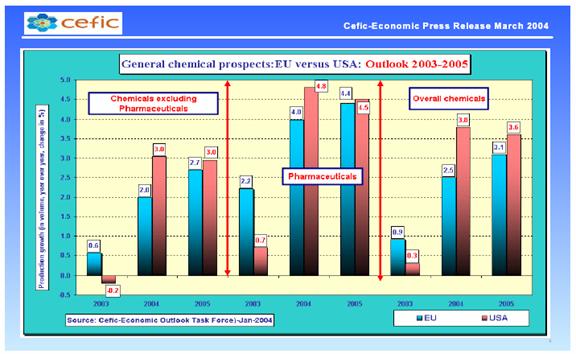
Chart 2:
European Chemical Industry: Sectoral Outlook: 2004-205

US
Emerging
from a four-year slump, U.S. chemical makers are
enjoying a rare confluence of strong demand and soaring retail prices that
analysts see lasting through year-end, despite rising raw-materials costs.
Second-quarter
2004 profits showed striking gains as the improving economy stimulated demand
for chemicals essential to manufacturing, agriculture and consumer products.
"We're
very bullish on the outlook for chemical companies in the second half,"
said Fulcrum Global Partners analyst Frank Mitsch. "Positive second-quarter
performances should continue as economic demand continues to improve, albeit
more slowly."
The
U.S. chemicals industry generates $460 billion a year in revenue and accounts
for 10 cents of every U.S. export dollar, according to the American Chemistry
Council.
Dow
Chemical reported a 74 percent profit jump on a record $9.84 billion in sales.
The Midland, Michigan-based company told investors to expect continued strong
earnings in the second half, though it declined to be more specific.
DuPont,
which carries a $42.6 billion market value and is one of 30 companies in the Dow
Jones Industrials index, also posted higher net sales and raised its full-year
earnings forecast..
BASF
reported its North American operations saw an 11 percent sales increase on
higher volumes and retail prices.
Many
chemicals plants are now running flat out since the industry slashed production
capacity in 1999 as economic crises overseas, deteriorating demand, and a strong
U.S. dollar triggered a market slump.
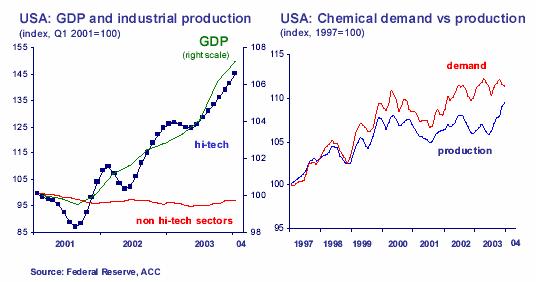
On
an annual basis, in 2004 US Chemicals will grow 3%, less than overall industry
(3.5%) and GDP (4.1%). Even with a strong macroeconomic recovery, the chemical
demand is not very dynamic.
CHINA
Compared
with European and US chemical companies, most domestic Chinese chemical
enterprises have remained technologically challenged with productivity lagging
behind international levels.
China's
entry into the WTO regimen in September 2001 has since enabled the chemical
industry to harness the benefits of a globalized economy.
The
Chinese chemicals industry is now expected to maintain an annual growth rate of
nine per cent through 2005. Rising foreign investments have aided domestic
chemical companies in creating globally competitive products. However, the entry
of foreign participants into the Chinese chemical market has challenged the
previously existing monopoly status of local refining and chemical production
industries.
Sinopec
Corp. is the largest producer of chemicals in China.
Summarized below are the capacity, production and market shares of its
major chemical products by the end of 2003.
Sinopec
Corp. has five ethylene plants, with a total capacity of 2.865 million tpa in
end of 2003, accounting for 51.9% of the nation's total. The Company produced
3.1691 million tones of ethylene in 2003, with a utilization rate of 111.29%.
Among the five, ethylene crackers in Shanghai Petrochemical, Beijing
Yanshan Petrochemical, Qilu Petrochemical and Yangtze Petrochemical are above
450,000 tpa, and the biggest one is in Shanghai with a total capacity of 845,000
tpa.
There
are 16 synthetic resin producers under Sinopec Corp. with a total capacity of
4.28 million tpa and the actual output in 2003 was 4.691 million tons. The
domestic market share of polyolefin is 36.72%. The high-quality specialty grades
account for 53.4% of the total polyolefin products.
There
are 10 producers of fiber raw materials and polymers under Sinopec Corp. with a
total capacity of 4.77 million tpa. In
2003, we produced 4.418 million tons of monomers and polymers for synthetic
fiber, accounting for 23.1% of the domestic market, being a market leader in
China.
There
are 7 synthetic fiber producers under Sinopec Corp., the capacity of polyester
fiber, acrylic fiber, polyamide fiber and polypropylene fiber totals 1.43
million tpa. In 2003, we produced 1.28 million tons of synthetic fibers, among
which 37.31% were special-purpose differential fibers. The domestic market share
of synthetic fibers is 10.45%. Sinopec Corp., with the country's largest
synthetic fiber production capacity, advanced facilities, strong technical
support, economies of scale and is in a leading position in the domestic market.
Sinopec Corp. has 3 synthetic rubber plants, with a capacity of 455,200 tpa. In
2003, we produced 501,900 tons of synthetic rubber, acquiring 22.79% of the
domestic market share.
Sinopec
Corp. has 7 urea plants, with a capacity of 3.73 million tpa.
In 2003, we produced 2.02 million tons of urea, accounting for 6.09% of
the domestic market
In
2003, the Company continued to coordinate and optimize supply of chemical
feedstock, and actively promoted its operational experience in a long run and
thus maintained the high utilization of chemical facilities. As a result, the
production of its major petrochemical products has all increased in
dramatically. In 2003, the Company produced 3.169 million tonnes of ethylene, up
by 16.67% over that in 2002. Accordingly the production of its major chemical
products, such as synthetic resins, synthetic fibers, monomers and polymers for
synthetic fibers, and synthetic rubber, etc., have all increased significantly.
Since the Company resorted to scientific and technological advancement to
improve its product mix, the production of high value-added products was further
enhanced. Furthermore, the Company actively tapped the market, and managed to
register a growth in terms of the production outputs, prices and distribution
volumes of its chemical products. In addition, the Company proactively carried
forward the reform to its distribution system of chemical products, and
established Acrylic Fiber Sales Company,, thus making a solid stride forward in
terms of reforming its chemicals marketing system.
| The Output of Major Chemical Products (as of December 31, 2003) | |||||
| Product Name | 2003 Cpty. (10,000 tpa.) | 2003 Production (10,000 ton) | Property & Application | Producer | Sales Contact |
| Synthetic Resin | |||||
| LDPE | 67.8 | 77.71 | LDPE is non-toxic, odorless, in opal cylindrical granules of non-lustrous surface, with low density, very good extensibility, and electric-insulation, transparency and insulation properties. It is mainly used in agricultural films (greenhouse and mulching), heavy-duty packing film, shrinking film, transparent film, insulator, and electric-wire and cable sheath. It can also be processed with injection molding, exrusion molding and foam expansion. | Beijing Yanhua, Shanghai Petrochemical, Qilu | Yangzi: 025-7784357 SPC: 021-579419412 |
| HDPE | 81.5 | 89.46 | HDPE is in non-toxic, odorless and white granules, with excellent heat resistance and freeze resistance, good chemical stability, good rigidity and toughness, good mechanical strength, dielectric properties, and resistance to fracturing by ambient stress. It is used for the manufacture of various types of tubes, sheets, plates, containers and tows. It finds applications in water pipes, sewage pipes, gas pipes, corrosion-resistant fluid pipes for application under - 80 ŃC, and linings and coating for chemical facilities. Tows can be used for ropes, fishing nets, packing straps and fibers for woven materials. It is also used for the manufacture of corrugated-board boxes, boxes for transfer transport, various kinds of bottles and buckets, and large-size storage vessels. | BeijingYanhua, Shanghai Petrochemical, Qilu, Yangzi | Gaoqiao: 021-58676240 Tianjin: 022-63805570 Yizheng: 0514-3231029 |
| LLDPE | 46 | 47.74 | LLDPE is in non-toxic, odorless and opal granules, with good strength, toughness, rigidity, and good heat resistance, freeze resistance, resistance to fracturing by ambient stress, good impact resistance and tearing strength, and good resistance to acid, alkali and organic solvent. It is mainly used for mulching film, packing bags, foodstuff bags, container linings, coating, and blow-molded small-size stuff such as hollow containers. It is also used for the manufacture of co-extrusion, doctor-blade cast film, and, after crushing, for rotational-molded products. | Yangzi, Qilu, Guangzhou | Baling: 0730-8536694, Guangzhou: 020-82121528 |
| PVC | 23 | 24.48 | PVC is fire retarding and self-extinguishing, with extremely good chemical resistance and corrosion resistance, electric insulation, chemical stability and thermoplasticity. It is insoluble in water, alcohol and gasoline, but expands or dissolves in ether, ketone and arene. It is white amorphous powder in appearance. PVC is used for the manufacture of transparent sheets. It can be calendered or extruded into rigid and semi-rigid sheets, plates, floor materials and rigid linings. It can be injection-molded into connectors, valves, electric parts, auto parts and containers. It can also be used for flexible films, chips, artificial leather, pipes, shaped materials, corrugated tubes, cable sheath, packing film, hose, shoe soles, and various types of flexible material. | Qilu | Anqing: 0556-5375163, Jinling: 025-5094473, Jingmen: 0724-2211902 |
| PS | 15.1 | 11.06 | PS is in odorless, non-toxic white granules, with very good rigidity, transparency, electric insulation, corrosion-resistance and fluidity. Processing is easy. It is injection-molded into high-gloss parts for telephone sets, vacuum cleaners and videocassettes. It can be injection-molded into various types of containers for foodstuff, medical, pharmaceutical and daily applications. It can be extruded into sheets and film, and can be foam-expanded for packing of hot food. It can be injection-molded into thin-wall containers and daily appliances. | Beijing Yanhua, Gaoqiao, Qilu, Guangzhou | Jiujiang: 0792-8494281, ZRCC: 0574-86446230 |
| PP | 192.25 | 216.7 | PP is an odorless, non-toxic and light thermoplastic resin, in greige granules, with excellent mechanical properties, good heat resistance, chemical stability, acid resistance, alkali resistance and resistance to organic solvents. It does not react with most chemicals, and is almost non-hydroscopic. It is used for the manufacture of biaxial stretching film (BOPP), split fiber (for agricultural ropes, thin ropes, spinning, etc.) filament, stretching film, doctor-blade cast film, hollow plates, sheets, etc. | Beijing Yanhua, Shanghai Petrochemical Company, Qilu, Yangzi, ZRCC, Guangzhou, Shijiazhuang, Anqing, Fujian, Jiujiang, Jinan, Wuhan, Jingmen, Changling, Henan Oilfield. | Shijiazhuang: 0311-5160090, Fujian: 0595-7799140, Hubei: 0717-4212012, -2344 |
| BR | 20.08 | 26.28 | Cis-butadiene rubber is white or yellowish in color, of high elasticity, low hysteresis loss and thermal generation, good low-temperature properties, good filling performance and fluidity in molds, and excellent abrasion resistance and flex fatigue resistance. It is a general-purpose synthetic rubber, can be mixed with natural rubber, chloroprene rubber and acrylonitrile-butadiene rubber. It is widely used in the manufacture of tire soles, various types of rubber tubes, belts, sealing gaskets, and shoe soles, etc. | Beijing Yanshan, Gaoqiao, Qilu | |
| SBR | 16.3 | 14.95 | SBR is a general-purpose synthetic rubber. Common grades include SBR-150, SBR-1502 and SBR-1712. It is good in abrasion resistance, resistance to atmospheric aging, ozone resistance, water resistance, air-tightness, and homogeneity, and can be mixed with natural rubber in any proportion. The green stock of SBR-1500 is of excellent adhesion performance and processability. When vulcanized its tensile strength, tearing strength, and anti-aging properties are excellent. The green stock of SBR-1502 is of very good tensile strength, abrasion performance and flex fatigue resistance. It is widely used for products with bright or light color, such as tire sides, transparent rubber shoes, coated fabric, medical products, and other color rubber products. SBR-1512 is of excellent adhesion performance, abrasion resistance and processability. It is widely used for trad compound and tread pattern for tires, conveyor belts, rubber tubes and normal black rubber products. | Qilu, Beijing Yanhua, Gaoqiao | |
| Monomers and polymers of synthetic fibers | |||||
| Ethyl Glycol | 57 | 45.04 | EG is a colorless and odorless thick liquid, mainly used as raw material for polyester, but also used as a solvent, or for preparation of anti-freeze fluid. It can also be used for the production of resin, plasticizer, cosmetics and dynamite. | Beijing Yanhua, Shanghai Petrochemical Company, Yangz | |
| Acrylontirle | 25.7 | 24.08 | AN is a colorless liquid with a pungent odor. It is volatile and hyper toxic, mainly used in the production of Nitrilon, acrylonitrile-butadiene rubber, ABS resin, AS resin, and polyacrylamide. | SPC, Gaoqiao, Anqing, Qilu | |
| Caprolactom(CPL) | 13.5 | 12.45 | Caprolactam is mainly used for the manufacture of cord plies, engineering plastics, films, or Nylon 6 filament and staple fiber for garment, decoration and industrial applications. | Shijiazhuang, Baling | |
| PTA | 165.5 | 175.59 | White needle-shape crystal or powder, it is an important raw material for the production of polyester. | SPC, Yangzi, Yizheng | |
| PET | 183.98 | 174.34 | PET is mainly used for the manufacture of terylene fiber or film and containers. | Beijing Yanhua, SPC, Yizheng, Tianjin | |
| PVA | 3.83 | 4.38 | PVA is mainly used for the manufacture of vinylon, construction coating material and sizing material for the textile industry. | SPC | |
| Synthetic Fiber | |||||
| Polyester fiber filament | 36.11 | 27.24 | Polyester fiber filament is used for the production of low-stretch yarn and draw-texturing yarn. It can be co-spun with other synthetic fibers for fabrics and garments. | SPC, Yizheng | |
| Polyester fiber staple | 70 | 52.09 | It is of good strength and low elongation, low defects rate, good crimping, moderate oil content, low dry and thermal shrinkage percentage, good spinnability, soft and smooth feel, good fiber-to-yarn quality, and low unevenness of strands. It can replace imported products in making silk-like, satin-like and wool-like fabrics and sewing threads, etc. | SPC, Tianjin, Yizheng | |
| Acrylic fiber | 30.89 | 35.27 | Acrylic fiber staple can be used alone or co-spun with cotton into cotton-type fabrics, or it can be used alone or co-spun with wool into wool-type fabrics and acrylic fiber toe. | SPC, Qilu, Anqing | |
| Plyamide fiber | 1.83 | 1.3 | Polyamide fiber can be used to produce polyamide fiber woven materials and cord piles. | Shijiazhuang, Baling | |
| PP fiber | 1.7 | 2.01 | It is made from PP through processes of spinning, stretching, crimping, heat setting, cutting and baling, etc. Good in moisture dispersion, soft, net formation, carding, cohesiveness and elongation. The product is safe, clean, non-hazardous, non-irritant and non-allergic. Good for non-woven cloth and PP fiber/cotton textiles. | SPC | |
| Fertilizers | |||||
| Urea | 384 | 202.76 | Urea is also called carbamide. It is soluble in water and alcohol. Its water solubility is faintly alkaline. It decomposes when heated over fusing point. Under high temperature, it can undergo a condensation reaction and form biuret, triuret and polyhydrocyanic acid. It is an ideal netural and fast-effective fertilizer, but can also be used as fodder for ruminant animals. It is also used as raw material for urea-formalehyde resin, plastics, paint, adhesion agent, and for pharmaceutical and foodstuff industries. In addition, it is used as an additive to raffinate solvent, fiber softening agent, and explosive stabilizer. | ZRCC, Jinling, Anqing, Jiujiang, Hubei, Baling | |
| Chemcials | |||||
| Methanol | 10 | 5.58 | Methanol is a colorless, volatile, and inflammable liquid. It is toxic. It will cause blindness if taken by mistake. It is easy to be oxidized or dehydrogenated to form formaldehyde, and can be used to produce many organic products such as formaldehyde, and can be used to produce many organic products such as formaldehyde, acetic acid, and dimethylester. It is used as raw material and solvent for fertilizer and pharmaceutics and can be added into gasoline as fuel. | Qilu | |
| Butanol | 5 | 6.04 | Butyl alcohol is a white, transparent liquid, can be blended with ethanol and diethyl ether. It can be used to produce dibutyl-phthalate, acetate-butyrin and organic phosphate type plasticizer. It can also be used to produce butanal, butyric acid, butyl amine, butyrin lactate and acrylic resin. | Qilu | |
| Octanol | 8.5 | 9.13 | Octanol is a white, transparent oily liquid, can be mixed with water into an azeotrope, and can be blended with many organic solvents such as alcohol, chloroform and ether. It is used to produce dioctyl phthalate plasticizer, synthetic lubricants, anti-oxidant, dehydrant and synthetic perfume. It can be used as solvent for adhesives, as anti-foaming agent for papermaking and dyeing industries, as dispersant for porcelain industry, and as floating agent for mining industry and as an additive for oil industry. | Qilu | |
| Benzene | 101.94 | 110.25 | Benzene is a colorless and volatile liquid. It is toxic and inflammable. It is an important material for synthetic rubber, synthetic resin, synthetic fiber, synthetic drugs and fertilizer. It can also be used as fuel and as solvent for coating, rubber and | Beijing Yanhua, Tianjin, Shijiazhuang, SPC, Gaoqiao, Jinling, Yangzi, ZRCC, Jiujiang, Qilu, Maoming, Changling, Guangzhou, Jianghan Oilfield | |
| Tolune | 30.6 | 38.95 | Toluene is a colorless, transparent and volatile liquid, with fragrance. It is soluble in ethanol, ether and acetone, can be blended with water and most hydrocarbons and alcohols into an azeotrope. It is mainly used as raw material for dyestuff, perfumes, benzaldehyde, benzoic acid and other organics. It can also be used as solvent for resin, acetic acid and other celluloses. | Shijiazhuang, Jinling, ZRCC, Jiujiang, Qilu, Changling, Guangzhou, Maoming | |
| Paraxylene | 132.9 | 89.42 | Paraxylene is a colorless and transparent liquid, with fragrance. It is mainly used to produce terephthalic acid for the production of polyester fiber. It is also used for other applications in chemical and pharmaceutical industries. | Tianjin, SPC, Yangzi, Qilu | |
| O-Xylene | 15.32 | 27.13 | O-xylene is a colorless and transparent liquid. It is toxic and inflammable. It is mainly used for the production of phthalic anhydride, dyestuff and pesticides. | Jinling, Yangzi, ZRCC, Qilu | |
| Phenol | 23.7 | 18.69 | Under normal temperature, phenol is in white needle-shape crystals or crystalline clots. It is mainly used for the production of bisphenol A, alkylphenol, epoxy resin and bakelite. | Beijing Yanhua, Gaoqiao | |
| Acetone | 14.7 | 11.61 | Acetone is a colorless and transparent liquid, with a pungent odor. It is mainly used as solvent and for plexiglass. | Beiijing Yanhua, Gaoqiao | |
| Acetic Acid | 13 | 11.39 | Acetic acid is a colorless, clear liquid, with a pungent odor. It is mainly used for the synthesis of vinyl acetate, acetate base, acetate and halygenated acetic acid. It is also an important raw material for pharmaceutics, dyestuff, pesticides and other organic synthesis processes. | SPC, Yangzi | |
| Caustic soda | 30.3 | 31.45 | Pure sodium hydroxide is white and transparent crystals. Industrial caustic soda contains a small quantity of sodium chloride and sodium carbonate, being a white, opaque solid, and highly water-soluble. Diaphragm alkali lye, the water solution of sodium hydroxide, is strongly alkaline and highly corrosive, and can react with many organic and inorganic compounds. It is widely used in artificial fiber, papermaking, printing and dyeing, soap, pigment, textile, pharmaceutics, glass and enamel, and metal processing industries. It is also an important raw material for agricultural pesticides, battery, tannery, organic synthesis, and electroplating. | Qilu, Jianghan Oilfield | |
| Production of Major Chemicals Unit 1,000 Tonnes | ||||
| 2003 | 2002 | 2001 | Change from 2002 to2003% | |
| Ethylene | 3,169.10 | 2,716.40 | 2,153 | 16.67 |
| Synthetic Resins | 4,691.00 | 4,004.80 | 3,204 | 17.13 |
| of which: performance resins | 2,304.90 | 1,846.90 | 1,332 | 24.8 |
| Synthetic Rubbers | 501.9 | 457.7 | 398 | 9.66 |
| Monomers & Polymers for Synthetic Fibers | 4,417.50 | 3,833.50 | 3,598 | 15.23 |
| Synthetic Fibers | 1,279.50 | 1,153.00 | 1,028 | 10.97 |
| of which: differential fibers | 477.4 | 402 |
326 |
18.76 |
| Urea | 2,027.60 | 2,666.30 | 2,342 | (23.95) |
| Notes: all the operating data excluded Maoming Ethylene | ||||